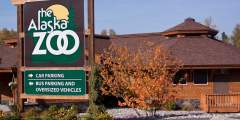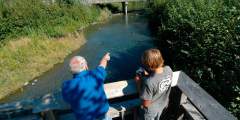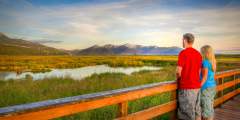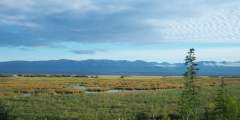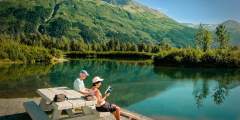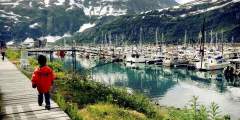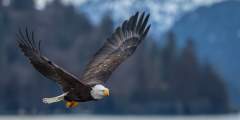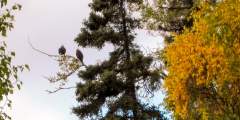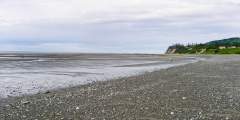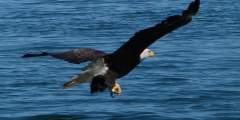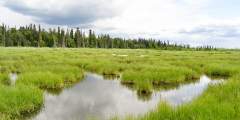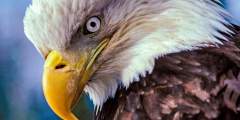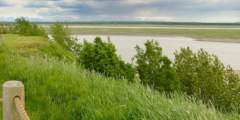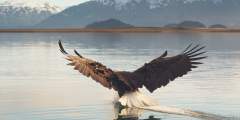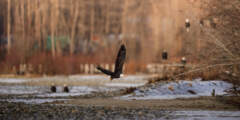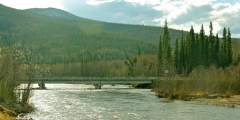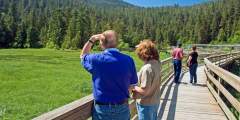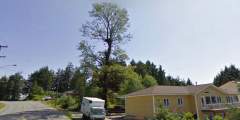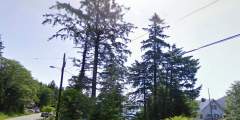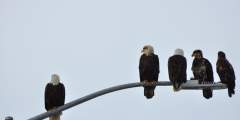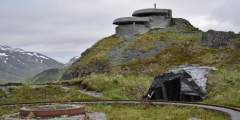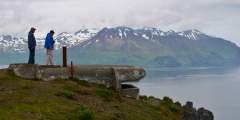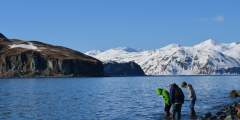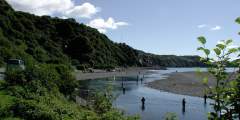Where to See Bald Eagles in Alaska
America’s national bird is easy to see in Alaska—especially in marine zones and river valleys where they forage for fish and scavenge carcasses. The state’s 30,000 eagles generally concentrate in Southeast Alaska, Prince William Sound, Southcentral coastal zones, Kodiak Island and down the Alaska Peninsula to the Aleutian Chain. These striking birds raise their young in large, treetop nests and have a habit of forming noisy congregations near fish runs (and garbage dumps!) They have long been icons for Alaska’s pristine environment, though they are regular visitors to towns and have a tolerance for human activity. It’s all about the food!
JUMP TO: MAP | Chilkat Bald Eagle Preserve | Turnagain Arm | Kenai River | Road System Boat Harbors | Southeast Alaska and Prince William Sound | Guaranteed Viewing | General Advice
Popular Spots
The crux to finding eagles, really, is to keep watch and listen for their calls. Here are a few locales with almost certain prospects.
Alaska Chilkat Bald Eagle Preserve
Mile 8 through 31 of the Haines Highway
The largest gathering of bald eagles in the world occurs each fall on the Chilkat River north of Haines. Between 3,000 and 4,000 eagles converge to feast on a late run of chum salmon that lingers deep into winter. Visitors regularly see scores of eagles in a single glance—perched, feeding, making calls and jousting over fish. This unique natural phenomenon anchors an annual festival each November during the peak, but large numbers of eagles might be present in the 48,000-acre park on any week from October through February.
Turnagain Arm
Especially south of Girdwood about 40 minutes from Anchorage
The vast tide flats along the Seward Highway southeast of Anchorage attract large numbers of bald eagles when fish are present. During the hooligan run of May and early June, dozens of eagles will patrol channels exposed during low tide and perch on the mud, especially in the upper arm between Twentymile River and Girdwood. The late summer run of coho salmon can also concentrate the birds. With many places to stop along a 45-mile road-accessible stretch, the arm offers great viewing potential for eagles (and other wildlife) all summer.
Kenai River
Check parks, boat launches and overlooks along Sterling Highway, 2-4 hours from Anchorage
Bald eagles are almost synonymous with the Kenai River and its fabled runs of salmon, and it’s easy to catch sight of our national bird at fishing areas or just about any place with a sweeping vista of the river. Prime time will be July through September, when the river fills with salmon and their spawned-out carcasses. Try Sportsman’s Landing near the Russian River ferry, or sweeping overlooks of the Kenai River estuary at the river viewing platform and the bluff-top Eric Hansen Scout Park in town. The Sterling Highway corridor between Seward and Kenai in general draws many eagles. Watch and listen at every stop.
Road System Boat Harbors
Visit the waterfront, and listen
Bald eagles are common in and around Whittier, Homer, Seward, and Valdez waterfronts. The Homer Spit, in particular, is well known for concentrating eagles, a phenomenon once boosted by care and feeding from the famous Homer Eagle Lady. Visitors can drive to Whittier, Homer, Seward and Valdez. Cordova, another Southcentral Alaska harbor, can be reached by air (and sometimes by ferry.)
Southeast Alaska and Prince William Sound
A regional paradise for bald eagles
Alaska’s coastal temperate rain forest is prime bald eagle habitat, with lone eagles or mated pairs present on just about every bight and cape. Take a beach walk (like Eagle Beach in Juneau) or get out one of the many marine tours or day trips (Whittier and Southeast) available in just about every port. Watch for the birds perching on spruce crowns, or peeking over the rim of one of their colossal nests. Listen for their calls.
Guaranteed Bald Eagle Viewing
Alaska Zoo
4731 O'Malley Road in South Anchorage
If you don’t mind viewing birds under human care, bald eagles (and golden eagles of the Interior) can be seen up close in aviaries at this popular Anchorage attraction. Most captive birds were rescued or injured, and cannot live free.
Bird Learning & Treatment Center
Above Potters Marsh at 15510 Old Seward Highway
The Bird Learning & Treatment Center in Anchorage often cares long-term for bald eagles that cannot be released and displays them during educational programs. Contact to find out details on a program, a bird release, or a visit.
American Bald Eagle Foundation
Haines
Individual captive eagles are among the “avian ambassadors” in residence at the American Bald Eagle Foundation. This educational center also sponsors the annual Alaska Bald Eagle Festival in early November, after thousands of eagles converge on the Chilkat River to feed on late-run salmon.
American Raptor Center
Sitka
The Alaska Raptor Center provides medical care to more than 200 injured birds each year, and cares for several bald eagles that can’t be released.
Alaska Rainforest Sanctuary
Ketchikan
The Alaska Rainforest Sanctuary in Ketchikan hosts an exhibit and program from the Alaska Raptor Center during summer months, usually with rehabilitated bald eagles on display.
Congregations Near Community Landfills
Most of Alaska’s landfills and municipal dumps attract bald eagles. Think of these raptors as savvy opportunists—ever in search of easy eats. They do not hesitant to compete with ravens and seagulls for human jetsam and will stage in large congregations near reliable food sources. For instance, a dozen or more eagles regularly perch in trees overlooking the Tsalteshi Trails by Skyview High on the Sterling Highway south of Soldotna—a location with an uphill vantage of the Soldotna Landfill. Check with officials in whatever community you’re visiting for tips and access.
General Advice:
- Adult eagles (over three years) all look alike—white head, brown body. Scan tidal flats and river valleys for this unique, standout image, with a particular eye toward treetops. Once you’re attuned to their indelible appearance, you will start finding an eagle or two at nearly every stop.
- Listen for their calls. Eagles often throw back heads and produce a high-pitched, hair-raising trill that is like no other bird call in Alaska. (An eagle congregation can sound almost like the soundtrack from an old-time Hollywood jungle movie.) You will frequently hear your eagle before you see it.
- Carry good glass. While eagles will sometimes land nearby or glide just overhead, most often you’ll find them perched across a valley or in a tree. Binoculars or spotting scopes will improve the experience.
- Seek out places where food gets scattered and exposed—salmon or hooligan runs, tidal flats that go dry, landfills and busy fishing ports.
- Once you find a congregation of perching eagles, be patient and the action will come. Birds that take wing often start harrying each other during flight—diving and chasing, locking talons and spinning in a brief free fall. An eagle eating a carcass will regularly get chased off by another, hungrier bird.
For More Information:
- Once hunted with a bounty in Alaska as potential competitors to commercial fishing—and listed as endangered or locally extinct in the contiguous 48 states—the species has rebounded and was removed from the Endangered Species Act in 2007. The birds were never endangered in Alaska.
- A bald eagle primer
- Bald eagle PDF from Alaska Wildlife Notebook
Show Map
BALD EAGLE VIEWING SPOTS
Near Anchorage
The Alaska Zoo started in 1966 with one baby elephant named Annabelle that was won in a contest. Since then, it has expanded to include over 77 animals across 25 acres of the Anchorage hillside.
Crystal-clear Williwaw Creek and its bank-side trail system in Portage Valley at the head of Turnagain Arm offers exceptionally good conditions for watching spawning in action. Coho, sockeye and chum salmon converge on the creek as it winds through the brushy flats beginning in mid-August, with some late-arriving fish still present after first frost in the fall.
Here you’ll find one of the most accessible wildlife viewing areas in Alaska. The marsh is a rest area for migratory birds including trumpeter swans, rednecked grebes, golden eyes, and pintails. Also watch for beavers, moose and bald eagles. You may even spot salmon spawning in the deeper water.
Visible outside the windows of the Mat-Su Convention and Visitors Bureau, this state wildlife refuge is the result of the 1964 earthquake. Literally overnight, the land dropped by 6 to 20 feet; hay fields and pastureland became salt flats and marshland. Once home to cows and grains, the land is now prime habitat for moose, birds, and fish. Some 20,000 acres are protected in the refuge, which is a popular recreation and wildlife-viewing… ...more
Located at Mile 1.0 of the Portage Highway, this site has a short boardwalk trail along several ponds. It is a good site for observing waterfowl that nest and rear their young in the ponds and river channels.
Harbor seals and sea otters are common sights in the Whittier Small Boat Harbor. You might also see salmon enthusiastically leaping from the water, a sight that cues locals to run for their fishing poles. King salmon run from May through early-July. From late-July through early-September, a run of silver salmon brings anglers from throughout Southcentral Alaska.
Bald eagles can be seen from just about any highway pullout and trailhead along Turnagain Arm, a stunning world-class fiord that stretches southeast from Anchorage for almost 50 miles along the Seward Highway.
Seward
At the Seward Small Boat Harbor look out at the rock jetties and buoys. Eagles like to sit on these spots and monitor their domain. Food is also plentiful from fisherman cleaning fish, seabirds that stay in the area and fish that return to the streams nearby.
Homer
This is an easy place to watch an active eagle nest in the top of a spruce tree. There had been a nest prior to this one in a dead spruce but it fell in a past winter storm. The eagle pair quickly built this new nest a short distance away in a live spruce. If you have time to watch, you may see the parents bringing in food for the youngster. There is a lot of activity at this nest and it is s great place to get good photographs of… ...more
Sounds Wild: AltricialFor many years an elderly lady fed eagles at this spot during the winter months: “The Eagle Lady of Homer Spit.” Her house was right on the beach and she received fish waste from a local fish processor, which she would then give to the hundreds of eagles that would show up for their daily feeding. After she passed away this practice of feeding the eagles was stopped.More Information ...more
Everyone wants to explore a tidepool, don’t they? This is a must for the kids — even that little kid in those slightly more mature visitors. Here’s the perfect spot. Bring a towel and let’s have an intertidal adventure.
The spit has a reputation for attracting decent numbers of America’s national bird — drawn by myriad potential food sources from fishermen, seafood processing and a vast beach with a big tidal range and crashing surf.
Kenai / Soldotna
Definitely keep your eyes open here, there’s volcanoes, beluga whales, harbor seals, and tons of birdlife to be seen — depending on the season and weather, of course. Extra credit if you spot an owl!
The trail is half a mile long and takes you through a mature birch forest that is carpeted with devil’s club and watermelon berry plants. It’s an easy walking, ideal for small children, and ends at a small camping area on a slight bluff that overlooks Bishop’s Beach and Bishop Creek.
At the Soldotna dump you can sometimes see several hundred eagles at once.
Sounds Wild: Eagles Lifetime MatesWant to see a soaring eagle up close? Stop at this site near the senior center and walk out toward the bluff – not too close as the bluff is eroding. Eagles play in the wind along the bluff. If not flying they can be seen on the mud flats at low tide– looking for food that has washed downstream.More Information ...more
Stop off here during the summer for an eagle’s eye view of an annual Alaskan fishing frenzy. We really love our salmon, and it shows! Or, just count the bald eagles circling high overhead.
Sterling Highway (Tern Lake to Homer)
Deep Creek North is located on the north side of Deep Creek; this area has 29 campsites for vehicles up to 50 feet.
Stop here for a view of the Ninilchik River and watch for bald eagles which often soar along the river. You’ll also find walking paths and an interpretive information sign about the area.
Haines
The annual Alaska Bald Eagle Festival takes place in Haines during the second week of November at the peak of the largest congregation of eagles in the world. Drawn by a late run of chum and coho salmon, some 2,000 to 4,000 eagles converge on the Chilkat River Valley.
Each October and November, between 3,000 and 4,000 bald eagles descend upon this 48,000-acre preserve centered on river bottomlands a few miles north of Haines to feast on late runs of salmon. Eagles can be found throughout the preserve, however, with an estimated 300 to 400 of the birds in the area throughout the year.
Fairbanks
When you’re driving Chena Hot Springs Road, keep in mind that it’s best not to rush. This journey defines “scenic route” as a one-day road trip primed for spotting wildlife, exploring a new trailhead, and pulling over to cast a line.
Cordova
Learn about the amazing attributes of the Bald Eagle and how they live. Eagles are found throughout most of Southcentral Alaska and are quite prolific in and around Cordova, especially the Copper River Delta. Bald Eagle nests can sometimes be seen along the road while driving to Childs Glacier, 52 miles from Cordova. They also congregate where spawning salmon are found. The Power Creek road area located just a few miles from Cordova has… ...more
This river originates from the Lakina Glacier and the southern flanks of Mt. Blackburn, spilling into the Chitina River several miles downstream. Pulling over to the side of the road just after the bridge at milepost 44, one can explore upstream for around a half-mile before getting boxed out by the forest and a narrowing of the river.
Juneau
Aside from rivers where salmon are spawning, this is one of the best spots to watch bald eagles. They perch in trees and on rocks here, hunting for washed-up salmon and other food. It’s also a great place for a picnic, or to go beachcombing.
Sitka
Before the salmon return, it can be difficult to find bears. Instead of gathering at the salmon runs, they’re dispersed throughout beaches, tidal flats, and alpine meadows, grazing on fresh vegetation. The beaches and grass flats on the east coast of Kruzof Island offer prime grazing in May and June, and if you’re lucky, you just might see one. Even if you don’t, though, the island is still a great destination, with its black-sand beaches and… ...more
Ketchikan
Just outside Ketchikan, the Alaska Rainforest Sanctuary promises a close-up view of old-growth forest, salmon habitat, an historic lumber mill, totem carving, raptor exhibits, and chances to see black bear and other wildlife – all in under 3 hours! There’s no better introduction to Alaska’s Southeast than this showcase of ecology, wildlife, history and Native culture.
Mountain Point eagle nest is located near a side road just north of the Mountain Point boat ramp. As you are traveling south on the South Tongass Hwy, slow down as you pass the Mt. Pt. Maritime marker. Turn left onto the side road at the 35 MPH + curve sign. Pull off this road on the left into a quarry type area about ½ block from the highway and look north-northwest to a large Sitka Spruce.Size: MediumViewing: Medium ...more
Valley Park School eagle nest is on the hillside to the east. Pull into the parking lot and park close to the fire hydrant. Look above the right hand end of the dugout on the baseball field until you locate a large dead snag. Size: Medium-LargeViewing: Easy
Fawn Mountain School eagle nest is best seen from the school’s access road as you turn left off the South Tongass Hwy and head up the hill towards the school. Pull off the road to the left on the driveway. Look about 25 feet down from the top of the large Sitka Spruce tree to your southeast.
The Ketchikan Regional Youth Detention Center eagle nest is best viewed from two land-based locations. From the north edge of the Public Health parking lot (just north of the Mormon church) look above the left hand peak of the KRYDC. The alternative, and perhaps best viewing, is from the parking lot of Calvary Bible ChurchSize: MediumViewing: Easy
The Lama Head eagle nest can be viewed from the water. Look for a round gray boulder on the beach near the high tide line. Now let your eyes sweep about 35 feet to the right along the beach and then strait up to the treetops. If you look closely you’ll see the shape of a Lama in the trees. Look for the Lama’s long skinny neck, pointed nose to the left, peaked ears and a packsaddle. What you perceive to be a packsaddle IS the eagle’s nest.… ...more
Mecca Eagles Nest is a challenge to find from land or water. It is in a low-lying treetop above a waterfront brown home with brown roof. By land, turn seaward off the north Tongass Hwy, one driveway north of the Mecca at 11.3 mile NT. The nest can best be found during incubation and active feeding times when the white head of the adult eagle will show you this nest. Size: SmallViewing: Challenging ...more
The nesting pair have built a new nest just north of McClennan’s house on the point and near the water’s edge. It is very near the top of the tallest tree among the short immature spruce that grow there. Size: Small (but it makes the EALGES look biiiiigger!) Viewing: EasyDon’t spend so much time on the eagles that you miss the whales .…… BEHIND YOU!
The McClennan eagle nest is best viewed from the water north of Totem Bight State Park from a point in front of the Mickel home (gray with white trim). The nest is on the right hand side of a huge old-growth tree where the longest branch is attached, well below the lopped off top. This tree rises above the McClennan home. Size: Medium-LargeViewing: Medium-Easy
Danger Island is located west of Refuge Cove & north of Channel Island in the Tongass Narrows just north of Ward Cove. The Danger Island eagle nest is located under the crown of an umbrella-shaped tree at the point of where the trunk splits. It is best viewed from northwest of the island. Size: LargeViewing: Easy
Long Island, owned by Tim & Kay Long, is located south of Refuge Cove State Park and west of Refuge Cove Marina, about 8 ½ miles north of Ketchikan. The Long Island eagle nest is best viewed from the southwest side of the island by looking 1⁄3 the way down from the top of the largest tree on side of the island that you’re facing. Size: MediumViewing: Moderate
Nordic Tug (a.k.a Longshoreman Dock) Nest is only viewed from the water. Look SE towards the shore to the treetops growing about 100 yards (300ft) up the hill from the N. Tongass Hwy. Look for a cluster of dead Cedar spires. The nest sits among them like a mushroom on a shish-kabob! Size: Medium-SmalViewing: Moderately Difficult
Ward Cove Eagles Nest is in the western bight of Ward Cove, which is north of Ketchikan. It is located above the center of the western bight shoreline and can be best viewed from near the point. Look for a tall dead tree top about half the way up the steep hill side from the vicinity of this location. The nest is just below the dead section and on the left. Size: Medium-Large Viewing: Moderate ...more
The Dawson Point eagle nest is best viewed from the water just north of East Island near the NW entrance of Ward Cove. Locate a single thin snag on the right hand end of the Dawson Point skyline. Count 4 trees to the left. This is a large pyramid shaped dark green Sitka spruce with a flat notch near the top right side. Adults & chicks can be seen in season. Size: MediumViewing: Moderate
Saxman Nest can be seen seaward & slightly south of the City Hall parking lot just off the South Tongass Hwy. Look for this nest in a deciduous tree, which is rare for the area. Eagle’s usually don’t nest in deciduous trees! Size: Medium-LargeViewing: Easy
The Shoreline Nest is best viewed from land by turning off North Tongass Hwy at the north entrance to Shoreline Drive. When you are around address 5306, look seaward to the nest, which sits about 1⁄3 of the way down from the top of a tree. Size: Medium-SmallViewing: Easy
East Clump is an island at high tide directly across Tongass Narrows from the south end of Bar Harbor near Madison Lumber. The nest tree is on the south edge of East Clump and best viewed from the water.Size: MediumViewing: Moderate
Ready Mix Eagle Nest is equally seen from both the water and land. By land, turn west off of N. Tongass just north of Ketchikan Ready Mix & Quarry. Park or stand between the two picnic benches and look back over the cliff above the highway. The nest is in a huge treetop near the crown of a skyline prominent tree. You can see the nest by boat from a variety of angles.Size: HugeViewing: Easy ...more
At the Eagle Center, you can get up close to 10 rescued birds, including a golden eagle, great-horned owls and even a turkey vulture. One pair of bald eagles has mated for life and occasionally has babies to show off. Phone: 800−252−5158, 907−228−5530. Hours May-Sep: 8am‑4:30pm (daily) Winter: By appointment Admission $10/adult, $5 kids ages 2 – 11. ...more
Clover Pass Marker eagle nest is located north of the Clover Pass Resort on the tiny island with the navigational marker. Look for the nest in a tree!Size: MediumViewing: Easy! The best viewing angle is determined by the angle of the sun and because it is a small island location you can maneuver your boat for the best possible viewing.
Pup Island eagle nest is located on the north side of Pup Island in the Clover Pass area, north of Ketchikan. You can only see the nest from the water. Size: Medium-SmallViewing: Challenging, but the fishing is great in this area so you may seeing some eagle action on the water!
South Tongass Fire Department eagle nest can be seen from the parking lot by their old fire station off of South Tongass Highway, just south of the Mt. Pt. Boat launch. Check the largest Sitka Spruce in the stand of timber above the electrical substation and you’ll see the nest about 30 feet from the top. Size: MediumViewing: Moderate
Saguaro Cactus eagle nest can best be seen while traveling south along the north Gravina shore in the Tongass Narrows. Look for a large dead snag with a saguaro cactus arm sticking out on the right hand side. The eagle’s nest is on the south-southeast side of this dead snag and is best seen from fairly close to shore. It is adorned with grass and appears to cling to the backside of the tree, seemingly with no visible means of support.
The Vallenar Rocks Wildlife Viewing Area eagle nest is located in the northernmost of the Vallenar Islands. When approaching from the north you can find this nest just under the crown of the right-hand most clump of trees. It is small, but active and fairly easy to view. Size: SmallViewing: EasyStay far enough away from the Harbor Seals so that they are NOT scared off the rocks.
Guard Island Big Island Nest is located in the tallest clump of trees, about 180 feet south of the lighthouse. It can be seen from both sides of the island. From the GPS given, look back at the lighthouse, then to the left to the tallest clump of trees. This nest is nearly at the top of this cluster of trees. It is active every other year, alternating with Little #2 for the past several years. Look for Harbor seals on the rocks or in the Bull… ...more
Guard Little eagle nest #2 is located in the farthest right tree cluster on the smaller of the two Guard Islands as you approach from Pt. Higgins. It is small, but a bit easier to see than #1. If you position yourself right in front of the lighthouse, look back to the south at the tree cluster on the northernmost point of the little island and look about 8 feet from the top. The white head of the adult is seen during incubation & feeding.… ...more
Guard Little eagle nest #1 is located in the left hand most tree cluster on the smaller of the two Guard Islands as you approach the lighthouse from Pt. Higgins. It is small, difficult to see, but does have historical significance, as it was the first nest built on Guard Island since the trees had all been cut down over 100 years ago. Two fledglings were successfully raised here in the adults’ 2nd year of trying. The first year, the eggs… ...more
Kake
If you want to see salmon, eagles and black bear in their natural habitat, the view along Gunnuk Creek cannot be surpassed. Silver Spike Bridge over the creek is a good viewing point, or you can make your way to the nearby bear viewing platform at the old Gunnuk Creek Hatchery. Some call Gunnuk Creek “eagle highway” for the large number of eagles here when the fish are running. ...more
Nome
The rocky outcrop across the Solomon River usually hosts an active golden eagle nest. Look for a huge tower of sticks and splashes of whitewash and orange lichen in the vicinity of the nest and surrounding perching sites. Built by eagles and added onto in successive years, the nest i s distinctive for its large size, construction, and shape. When not occupied by eagles, the large nest may be used by gyrfalcons.
This high point in the road gives you an excellent view across the valley. Three ditch lines from earlier mining activities are apparent on the far side of the valley, especially where they cross the exposed rock face of Cape Horn. The ditches originate near Hudson Creek about 12 miles upstream. Today these deep, wide gashes on the hillside offer cover and easier movement for wildlife — especially moose and grizzly bears.
The Bluestone River is unlike other river crossings along the Teller Road because it flows northward to Imuruk Basin rather than south to Norton Sound. The river is deeply incised as it cuts through steep mountains, creating steep, rocky slopes and cliffs. Rough-legged hawk, golden eagle, gyrfalcon, and common raven may nest on nearby rock cliffs
As you approach the Tisuk River, scan downstream and across the river for a large nest of sticks on an orange lichen-covered rock outcrop. Built by golden eagles, it may be used by gyrfalcon when not occupied by eagles.
Unalaska
The mild stroll around Strawberry Hill offers great views, wildlife and some historic flavor. Old military roads cover the area, providing easy walking. Adventurers can bushwhack or scramble short distances for better views of the surrounding area or get up close to WWII-era trenches and the remains of old bunkers.
If your travel group includes a WWII enthusiast, a wildlife devotee, a birder, and a kid who enjoys rolling around on the tundra, Bunker Hill is the perfect spot. Plus, it has the best photo ops, with a 360-degree view of the entire area: Captains Bay, Amaknak Island, Unalaska Bay and Iliuliuk Harbor.
A drive or walk up Mt. Ballyhoo is interesting for both birders and those interested in World War II history. It’s such as good view that you might even catch sight of whales in the distance. The view from the 1,634-foot mountain gives you an idea of how birds might see the area (that is, if you can imagine the view with a lot more color and super-sharp clarity)
Unalaska’s Front Beach, on the shores of Iliuliuk Bay, is both inviting and picturesque. Looking toward the bay, watch for boats coming into harbor, eagles fighting over salmon, or mist engulfing the surrounding hills and mountain tops. Back toward Unalaska, you’ll find more emerald green mountain views and historic sites.
Kodiak
Look for salmon and bald eagles here.
A spectacular setting for anglers, beachcombers, hikers, and explorers. There is developed camping for both tent and RV campers, a boat launch, two modern pit toilets, and numerous picnic sites. The beach makes for excellent walking, beachcombing, wildlife viewing and birding.

